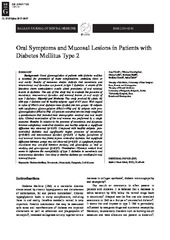Приказ основних података о документу
Oral symptoms and mucosal lesions in patients with diabetes mellitus type 2
| dc.creator | Cicmil, Ana | |
| dc.creator | Govedarica, Olivera | |
| dc.creator | Lečić, Jelena | |
| dc.creator | Mališ, Snežana | |
| dc.creator | Cicmil, Smiljka | |
| dc.creator | Čakić, Saša | |
| dc.date.accessioned | 2020-07-02T13:12:55Z | |
| dc.date.available | 2020-07-02T13:12:55Z | |
| dc.date.issued | 2017 | |
| dc.identifier.issn | 2335-0245 | |
| dc.identifier.uri | https://smile.stomf.bg.ac.rs/handle/123456789/2245 | |
| dc.description.abstract | Background: Good glycoregulation at patients with diabetes mellitus is essential for prevention of many complications, including those in oral cavity. Results of numerous studies indicate that xerostomia and neurosensory oral disorders are present in type 2 diabetics. A review of the literature shows contradictory results about prevalence of oral mucosal lesions in diabetics. The aim of this study was to evaluate the presence of xerostomia, neurosensory disorders and mucosal lesions in oral cavity of type 2 diabetics. Material and Methods: This study involved 90 adults, 60 with type 2 diabetes and 30 healthy subjects, aged 45-65 years. With regard to value of HbA1c level diabetics were divided into two groups: 30 subjects with satisfactory glycoregulation (HbA1c lt 9%) and 30 subjects with poor glycoregulation (HbA1c≥9%). All patients recruited into the study completed a questionnaire that included their demographic, medical and oral health data. Clinical examination of the oral mucosa was performed by a single examiner. Results: In relation to the presence of xerostomia and dysgeusia between satisfactory controlled diabetics and healthy subjects a significant difference was observed (p lt 0.05). Compared with healthy subjects, poor controlled diabetics had significantly higher presence of xerostomia (p lt 0.001) and neurosensory disorders (p lt 0.05). A higher prevalence of oral mucosal lesions was found in poor controlled diabetics, but significant difference between groups was not observed (p>0.05). A significant positive correlation was revealed between smoking and glossodynia as well as smoking and glossopyrosis (p>0.05). Conclusion: Glycemic control level seems to influence the susceptibility of type 2 diabetics to xerostomia and neurosensory disorders. Less clear is whether diabetes are correlated to oral mucosal lesions. | en |
| dc.publisher | Udruženje stomatologa Balkana | |
| dc.rights | openAccess | |
| dc.rights.uri | https://creativecommons.org/licenses/by-nc-nd/4.0/ | |
| dc.source | Balkan Journal of Dental Medicine | |
| dc.subject | diabetes mellitus | en |
| dc.subject | xerostomia | en |
| dc.subject | glossodynia | en |
| dc.subject | dysgeusia | en |
| dc.subject | oral mucosa | en |
| dc.title | Oral symptoms and mucosal lesions in patients with diabetes mellitus type 2 | en |
| dc.type | article | |
| dc.rights.license | BY-NC-ND | |
| dcterms.abstract | Малиш, Снежана; Цицмил, Aна; Чакић, Саша; Говедарица, Оливера; Лечић, Јелена; Цицмил, Смиљка; | |
| dc.citation.volume | 21 | |
| dc.citation.issue | 1 | |
| dc.citation.spage | 50 | |
| dc.citation.epage | 54 | |
| dc.citation.other | 21(1): 50-54 | |
| dc.citation.rank | M53 | |
| dc.identifier.doi | 10.1515/bjdm-2017-0007 | |
| dc.identifier.fulltext | https://smile.stomf.bg.ac.rs/bitstream/id/816/2240.pdf | |
| dc.type.version | publishedVersion |


